湘菜英文介绍
- 格式:ppt
- 大小:3.22 MB
- 文档页数:12
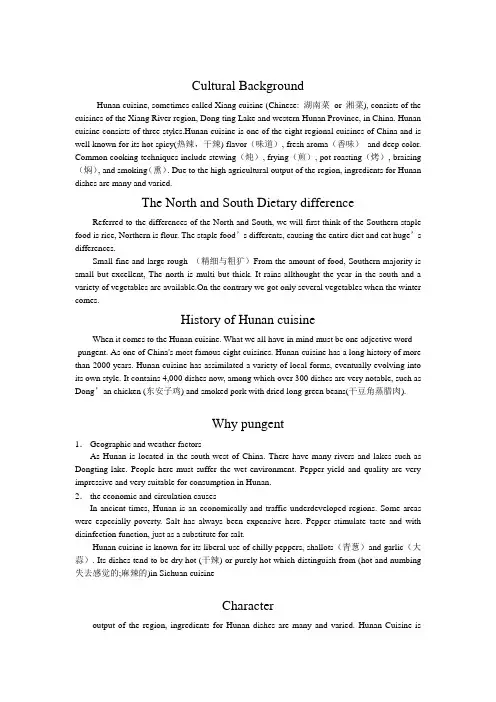
Cultural BackgroundHunan cuisine, sometimes called Xiang cuisine (Chinese: 湖南菜or 湘菜), consists of the cuisines of the Xiang River region, Dong ting Lake and western Hunan Province, in China. Hunan cuisine consists of three styles.Hunan cuisine is one of the eight regional cuisines of China and is well known for its hot spicy(热辣,干辣) flavor(味道), fresh aroma(香味)and deep color. Common cooking techniques include stewing(炖), frying(煎), pot-roasting(烤), braising (焖), and smoking(熏). Due to the high agricultural output of the region, ingredients for Hunan dishes are many and varied.The North and South Dietary differenceReferred to the differences of the North and South, we will first think of the Southern staple food is rice, Northern is flour. The staple food’s differents, causing the entire diet and eat huge’s differences.Small fine and large rough (精细与粗犷)From the amount of food, Southern majority is small but excellent, The north is multi but thick. It rains allthought the year in the south and a variety of vegetables are available.On the contrary we got only several vegetables when the winter comes.History of Hunan cuisineWhen it comes to the Hunan cuisine. What we all have in mind must be one adjective word -pungent. As one of China's most famous eight cuisines. Hunan cuisine has a long history of more than 2000 years. Hunan cuisine has assimilated a variety of local forms, eventually evolving into its own style. It contains 4,000 dishes now, among which over 300 dishes are very notable, such as Dong’an chicken (东安子鸡) and smoked pork with dried long green beans(干豆角蒸腊肉).Why pungent1.Geographic and weather factorsAs Hunan is located in the south-west of China. There have many rivers and lakes such as Dongting-lake. People here must suffer the wet environment. Pepper yield and quality are very impressive and very suitable for consumption in Hunan.2.the economic and circulation causesIn ancient times, Hunan is an economically and traffic underdeveloped regions. Some areas were especially poverty. Salt has always been expensive here. Pepper stimulate taste and with disinfection function, just as a substitute for salt.Hunan cuisine is known for its liberal use of chilly peppers, shallots(青葱)and garlic(大蒜). Its dishes tend to be dry hot (干辣) or purely hot which distinguish from (hot and numbing 失去感觉的;麻辣的)in Sichuan cuisineCharacteroutput of the region, ingredients for Hunan dishes are many and varied. Hunan Cuisine isoften spicier by pure chili content, contains a larger variety of fresh ingredients, tends to be oilier, and is said to be purer and simpler in taste An obvious characteristic of Hunan cuisine, in general, Hunan cuisine uses smoked and cured goods in its dishes much more frequently.And the menu changes with the seasons is another feature of Hunan cuisine.Famous Food of Hunan cuisine1Steamed fish head with chopped pepper(剁椒鱼头)The dish is bright red in color and tastes delicious. It is prepared with the head of a bighead carp and spicy thick sauce is made according to a secret recipe.2 Mao’s b raised pork with soy sauce (毛氏红烧肉)Red-braised pork is a dish that in Hunan is inseparably bound up with the memory of Chairman Mao: many restaurants cal it “The Mao family’s red-braised pork.”Mao Zedong loved it, ate it frequently, and is said to have insisted his Huananese chefs cook it for him in Beijing. It’s a robust concoction, best eaten with a plain steamed rice and simple stir-fried vegetables, but the sweet, aromatic chunks of meat are irresistible and it’s always a favorite at my London dinner parties. In keeping with traditional Chinese gastronomy, which seeks to make a medical virtue out of every dietary predilection, the people of Mao’s home village, Shaoshan, recommend a red-braised pork as a health food: “Men eat it to build their brains,”Chairman Mao’s nephew Mao Anping assured me when I met him there a few years ago, “and ladies to make themselves more beautiful”. His friend and neighbor, the Shaoshan communist party secretary, told me he ate two bowlfuls a day to keep his intellect in shape.3 Dong’an Chicken(东安子鸡)Named by its material—the pullet (young hen)Was handed down more than 1000 years from Tang DynastyIs one of the most famous Hunan dishes.4 Spicy Salted Duck(酱板鸭)“Jiangbanya duck”(Changde Spicy and Salted Duck), a local delicacy with a special flavor, is famous all over the country. This delicacy is eye-catching in color, crisp in flesh, fragrant in sauce and savory in taste. It is highly nutritious, and it is also a good choice as dish that goes with wine. It is not only a common local snack but also a speciality in a banquet.5 Changsha Preserved Smelly Tofu(长沙臭豆腐)Changsha stinky tofu features: crisp but not paste, delicate but not greasy, tangy smell bad smell early, fine smell inviting aroma, with white bean curd and fresh, crisp Fried tofu fragrance and crunchy.6 Smoky flavours steamed together(腊味合蒸)Is made by smoked and cured pork(腊肉)、chicken(腊鸡)and fish(腊鱼).Is one of the traditional style dishes of hunan cuisine.Hunan CuisineHunan cuisine, sometimes called Xiang cuisine (湖南菜or 湘菜;), is generally considered in China as one of the eight main cooking styles. Hunan dishes consist of local dishes from the Xiangjiang River area, Dongting Lake area and Western Hunan mountain area.What is Hunan cuisine famous for?The cuisine gives priority to abundance, fatness, smoothness and moistness, mostly take chili as the main course. It not only has the saltiness of the North and the sweetness of the South, but also the hotness and sourness of local characteristics.It is characterized by fragrance, tenderness, clearness and crispness. Its selected materials are based on the principle of being fresh and cheap but good. The cuisine is especially particular about the tastiness of raw materials.Hunan cuisine has varied cooking techniques such as sautéing, stir-frying, steaming and smoking. It is especially good at "stewing" dishes. However, it is most skillful in braising and baking, by which dishes of original flavor can be cooked.Hunan cuisine is also famous for its excellence in cutting techniques, appearance and flavor. The dishes are changeable with all shapes. The special seasonings of the cuisine include soy sauce, tea seed oil, spicy oil, Chinese red pepper, fennel and cassia bark, which add color to the cuisine, which is noted for pungency. The Hunan chili is especially spicy, and local people have a preference for chili which they put in almost everything they eat.How do the geographical factors affect Hunan cuisine?Hunan is known as "the land of fish and rice". Like the west in latitude, it has the added bonus of lowlands for rice cultivation and a rich ocean's edge for fish. So rice and seafood is common in Hunan cuisine.Hunan food is hot because the climate is very humid, which makes it difficult for human body to eliminate moisture. Local people eat hot peppers to help remove excess dampness and cold in the body.What are the features of Hunan cuisine?Chili, pepper and shallot are usually necessaries in Hunan cuisine. The characteristic of Hunan cooking is the liberal use of chillis, which gives it thick and pungent flavor. Hunan cuisine is known for being dry hot or purely hot. Hunan cuisine is often spicier and contains a larger variety of ingredients. Chili, peppers, garlic and an unusual sauce, called "strange-flavor" sauce on somemenus, enliven many dishes, with a somewhat drier intensity than thatof their Sichuan counterparts.Sweetness, too, is a Hunan culinary passion, and honey sauces are favored in desserts such as water chestnut or cassia flower cakes.Another feature of Hunan cuisine is that the menu will change following the season's alternation. In a hot and humid summer, a meal will usually start with cold dishes or a platter holding a selection of cold meats with chilies for opening the pores and keeping cool in the summer. In winter, a popular choice is the hot pot, for heating the blood in the cold months. A special hot pot called "lover's hot pot" is famous for splitting the pot into a spicy and a lighter side.What are the famous courses of Hunan cuisine?Representative dishes:Beer duck (啤酒鸭)Changsha-style rice vermicelli (长沙米粉)Changsha-style stinky tofu (长沙臭豆腐)Dong'an chicken (东安子鸡)"Dry-wok" chicken (干锅鸡)Home-style bean curd (家常豆腐)Lotus seeds in rock sugar syrup (冰糖湘莲)Mao's braised pork (毛氏红烧肉)Numbing-and-hot chicken (麻辣子鸡)Smoky flavours steamed together (腊味合蒸)Steamed fish heads in chili sauce (剁椒蒸鱼头)Stir-fried duck blood (炒血鸭)Stir-fried meat with douchi and chilli peppers (豆豉辣椒炒肉)Pearly meatballs (珍珠肉丸)Well-known Snacks:Pumpkin cakeFermented Bean CurdSisters‘Glutinous Rice BallsXiangtan RollHengyang Pailou Tangyuan (stuffed balls made of glutinous rice flour served in soup)Shrimp CakeRice TeaWhat is the established history of Hunan cuisine?The history of the cooking skills employed in the Hunan cuisine date back many centuries. As early as the Western Han Dynasty, 2,100 years ago, the cooking skills of Hunan cuisine reached a high standard. During the course of its history, Hunan cuisine assimilated a variety of cuisine styles, and then developed its own style. Now it contains more than 4,000 dishes, amongwhich over 300 dishes are very famous, such as fried chicken with Sichuan spicy sauce and smoked pork with dried long green beans.。
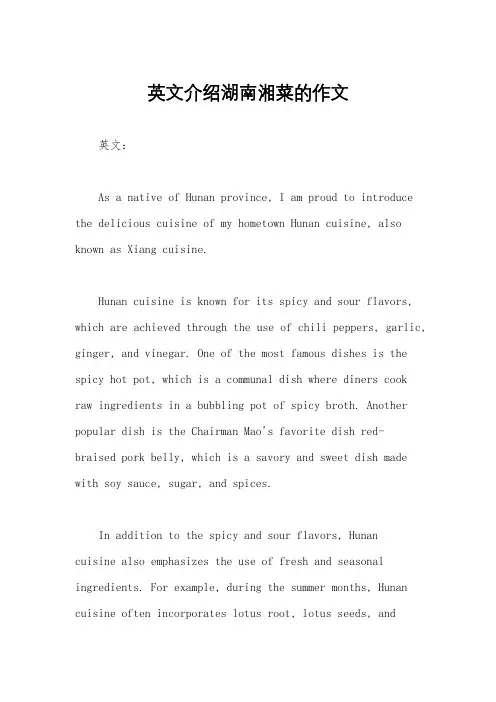
英文介绍湖南湘菜的作文英文:As a native of Hunan province, I am proud to introduce the delicious cuisine of my hometown Hunan cuisine, also known as Xiang cuisine.Hunan cuisine is known for its spicy and sour flavors, which are achieved through the use of chili peppers, garlic, ginger, and vinegar. One of the most famous dishes is the spicy hot pot, which is a communal dish where diners cook raw ingredients in a bubbling pot of spicy broth. Another popular dish is the Chairman Mao's favorite dish red-braised pork belly, which is a savory and sweet dish made with soy sauce, sugar, and spices.In addition to the spicy and sour flavors, Hunancuisine also emphasizes the use of fresh and seasonal ingredients. For example, during the summer months, Hunan cuisine often incorporates lotus root, lotus seeds, andwater chestnuts into dishes.Overall, Hunan cuisine is a delicious and diversecuisine that is sure to please any food lover. Whetheryou're a fan of spicy food or not, there is something for everyone to enjoy.中文:作为湖南人,我很自豪能够介绍我家乡的美食——湘菜。

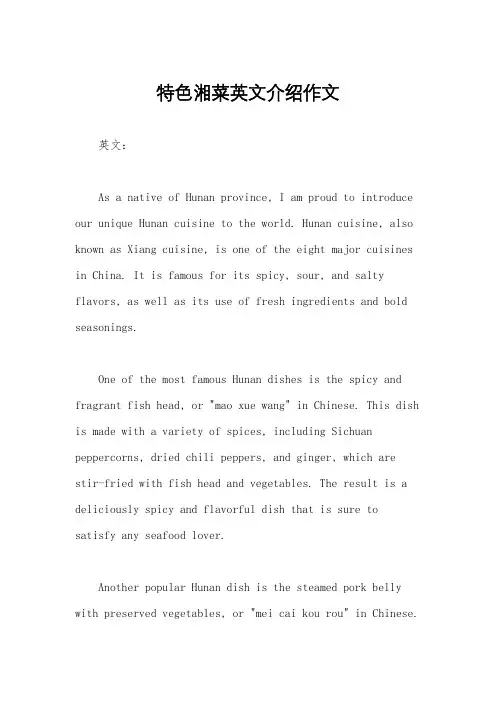
特色湘菜英文介绍作文英文:As a native of Hunan province, I am proud to introduce our unique Hunan cuisine to the world. Hunan cuisine, also known as Xiang cuisine, is one of the eight major cuisines in China. It is famous for its spicy, sour, and salty flavors, as well as its use of fresh ingredients and bold seasonings.One of the most famous Hunan dishes is the spicy and fragrant fish head, or "mao xue wang" in Chinese. This dish is made with a variety of spices, including Sichuan peppercorns, dried chili peppers, and ginger, which arestir-fried with fish head and vegetables. The result is a deliciously spicy and flavorful dish that is sure tosatisfy any seafood lover.Another popular Hunan dish is the steamed pork belly with preserved vegetables, or "mei cai kou rou" in Chinese.This dish is made by marinating pork belly in a mixture of soy sauce, sugar, and spices, and then steaming it with preserved vegetables. The result is a tender and flavorful dish that is perfect for any occasion.Hunan cuisine is also known for its use of pickled vegetables, which add a unique sour flavor to many dishes. For example, the famous Hunan dish "suan cai yu" is made with pickled cabbage and fish, resulting in a tangy and refreshing flavor that is perfect for summer.Overall, Hunan cuisine is a must-try for anyone who loves bold, spicy flavors and fresh ingredients. Whether you are a seafood lover, a meat lover, or a vegetarian, Hunan cuisine has something to offer for everyone.中文:作为湖南人,我很自豪地向世界介绍我们独特的湖南菜。
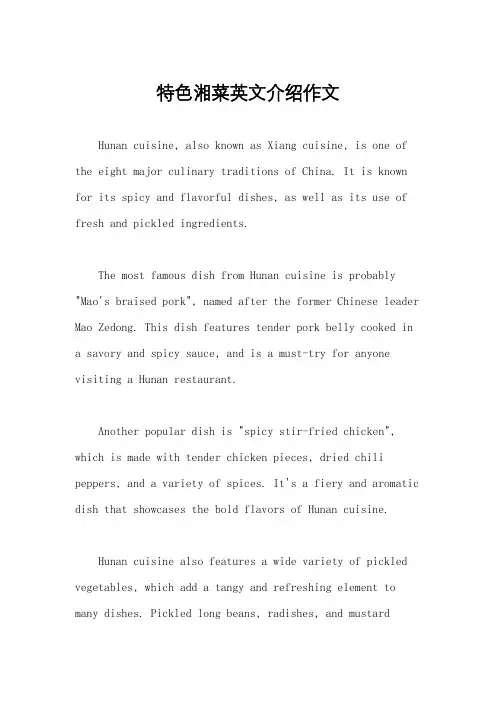
特色湘菜英文介绍作文Hunan cuisine, also known as Xiang cuisine, is one of the eight major culinary traditions of China. It is known for its spicy and flavorful dishes, as well as its use of fresh and pickled ingredients.The most famous dish from Hunan cuisine is probably "Mao's braised pork", named after the former Chinese leader Mao Zedong. This dish features tender pork belly cooked in a savory and spicy sauce, and is a must-try for anyone visiting a Hunan restaurant.Another popular dish is "spicy stir-fried chicken", which is made with tender chicken pieces, dried chili peppers, and a variety of spices. It's a fiery and aromatic dish that showcases the bold flavors of Hunan cuisine.Hunan cuisine also features a wide variety of pickled vegetables, which add a tangy and refreshing element to many dishes. Pickled long beans, radishes, and mustardgreens are commonly used in Hunan cuisine to balance out the spiciness of the dishes.One of the hallmarks of Hunan cuisine is its use of smoked and cured meats, such as smoked pork and cured ham. These meats add a rich and smoky flavor to many dishes, and are often used in combination with spicy ingredients to create a complex and satisfying flavor profile.In addition to its spicy and flavorful dishes, Hunan cuisine also offers a wide variety of soups and stews. One popular soup is the "sour and spicy fish soup", which features tender fish fillets in a tangy and spicy broth, flavored with pickled chilies and vinegar.Overall, Hunan cuisine is a bold and vibrant culinary tradition that showcases the rich flavors and diverse ingredients of the Hunan region. Whether you're a fan of spicy food or just looking to explore a new culinary experience, Hunan cuisine is definitely worth a try.。
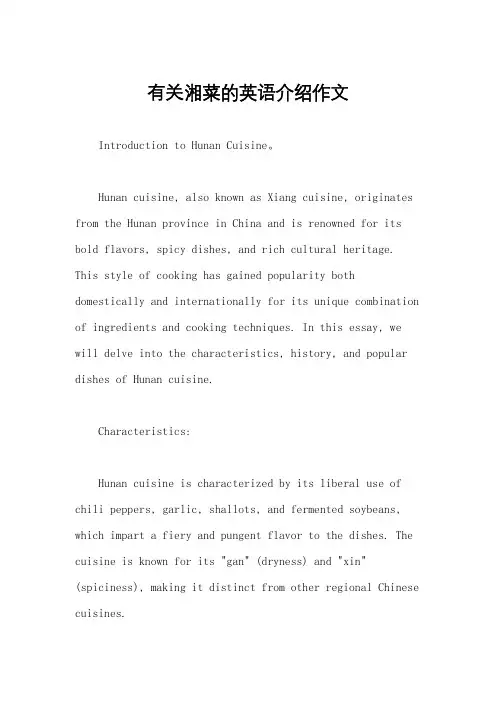
有关湘菜的英语介绍作文Introduction to Hunan Cuisine。
Hunan cuisine, also known as Xiang cuisine, originates from the Hunan province in China and is renowned for its bold flavors, spicy dishes, and rich cultural heritage. This style of cooking has gained popularity both domestically and internationally for its unique combination of ingredients and cooking techniques. In this essay, we will delve into the characteristics, history, and popular dishes of Hunan cuisine.Characteristics:Hunan cuisine is characterized by its liberal use of chili peppers, garlic, shallots, and fermented soybeans, which impart a fiery and pungent flavor to the dishes. The cuisine is known for its "gan" (dryness) and "xin" (spiciness), making it distinct from other regional Chinese cuisines.One of the key features of Hunan cuisine is its emphasis on preserving the original flavors of the ingredients while enhancing them with seasoning. This is achieved through techniques such as stir-frying, braising, steaming, and smoking, which help to retain the freshness and texture of the ingredients.History:The history of Hunan cuisine can be traced back to ancient times, with its roots deeply intertwined with the rich agricultural heritage of the region. The fertile soil and favorable climate of Hunan have nurtured a wide variety of crops and ingredients, which form the basis of its culinary tradition.Over the centuries, Hunan cuisine has evolved and adapted, incorporating influences from neighboring regions and foreign cultures. During the Qing Dynasty (1644-1912), Hunan cuisine gained prominence with the migration of people from other provinces, leading to the exchange ofculinary techniques and ingredients.In the modern era, Hunan cuisine has continued to flourish, gaining recognition both domestically and internationally. Its bold flavors and diverse range of dishes have captivated the palates of food enthusiasts around the world, cementing its status as one of China's most beloved regional cuisines.Popular Dishes:Hunan cuisine boasts a wide array of dishes, ranging from spicy stir-fries to hearty braised meats. Some of the most popular dishes include:1. Spicy Chicken (辣子鸡): Tender chicken pieces stir-fried with chili peppers, Sichuan peppercorns, and garlic, creating a fiery and aromatic dish.2. Dong'an Chicken (东安鸡): This dish features chicken braised with ginger, garlic, and chili peppers, resultingin a savory and spicy flavor profile.3. Chairman Mao's Red-Braised Pork (毛氏红烧肉): Named after the former Chinese leader Mao Zedong, this dish consists of succulent pork belly simmered in a fragrant sauce made from soy sauce, sugar, and spices.4. Hunan Hot Pot (湖南火锅): Similar to Sichuan hot pot, this spicy broth-based dish is filled with a variety of meats, vegetables, and tofu, simmered at the table and enjoyed communally.Conclusion:In conclusion, Hunan cuisine is a culinary treasurethat reflects the rich history, diverse ingredients, and bold flavors of the Hunan province. With its fiery spices, hearty dishes, and centuries-old tradition, Hunan cuisine continues to captivate the hearts and taste buds of food lovers worldwide. Whether you're craving something spicy or savory, Hunan cuisine offers a tantalizing culinary experience that is sure to leave a lasting impression.。
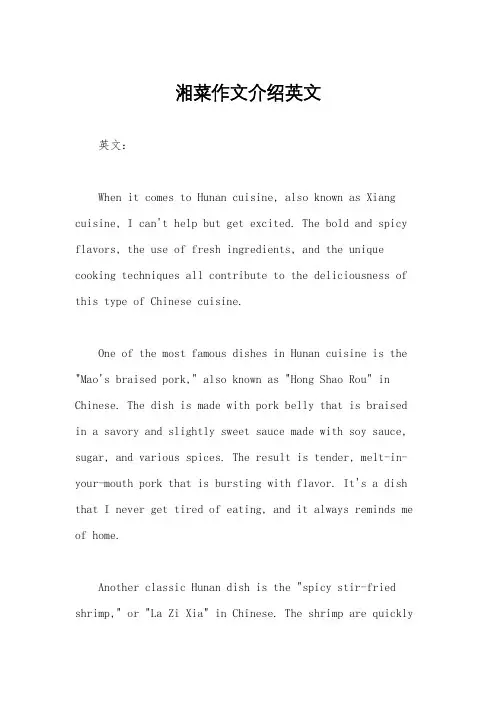
湘菜作文介绍英文英文:When it comes to Hunan cuisine, also known as Xiang cuisine, I can't help but get excited. The bold and spicy flavors, the use of fresh ingredients, and the unique cooking techniques all contribute to the deliciousness of this type of Chinese cuisine.One of the most famous dishes in Hunan cuisine is the "Mao's braised pork," also known as "Hong Shao Rou" in Chinese. The dish is made with pork belly that is braised in a savory and slightly sweet sauce made with soy sauce, sugar, and various spices. The result is tender, melt-in-your-mouth pork that is bursting with flavor. It's a dish that I never get tired of eating, and it always reminds me of home.Another classic Hunan dish is the "spicy stir-fried shrimp," or "La Zi Xia" in Chinese. The shrimp are quicklystir-fried with a generous amount of dried chili peppers, Sichuan peppercorns, and garlic, creating a dish that is both fiery and incredibly aromatic. The combination of the heat from the chilies and the numbing sensation from the Sichuan peppercorns is simply addictive.In addition to these iconic dishes, Hunan cuisine also features a wide variety of pickled and preserved foods,such as pickled long beans, mustard greens, and radishes. These pickles add a wonderful tangy and crunchy element to the meal, and they are a staple in my family's dinner table.Hunan cuisine is also known for its use of fresh and seasonal ingredients. For example, in the summer, dishes featuring lotus root, water chestnuts, and fresh green chilies are abundant, while in the winter, hearty stews and braised dishes using winter vegetables like turnips and radishes take center stage.Overall, Hunan cuisine is all about bold flavors, contrasting textures, and the celebration of fresh ingredients. It's a cuisine that is close to my heart, andit never fails to satisfy my cravings for something spicy and comforting.中文:说到湖南菜,也就是湘菜,我禁不住激动起来。
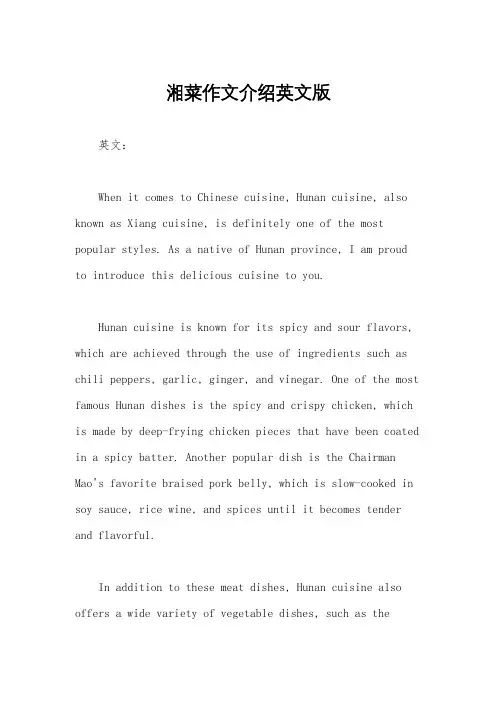
湘菜作文介绍英文版英文:When it comes to Chinese cuisine, Hunan cuisine, also known as Xiang cuisine, is definitely one of the most popular styles. As a native of Hunan province, I am proud to introduce this delicious cuisine to you.Hunan cuisine is known for its spicy and sour flavors, which are achieved through the use of ingredients such as chili peppers, garlic, ginger, and vinegar. One of the most famous Hunan dishes is the spicy and crispy chicken, which is made by deep-frying chicken pieces that have been coated in a spicy batter. Another popular dish is the Chairman Mao's favorite braised pork belly, which is slow-cooked in soy sauce, rice wine, and spices until it becomes tender and flavorful.In addition to these meat dishes, Hunan cuisine also offers a wide variety of vegetable dishes, such as thestir-fried eggplant with garlic sauce and the sautéedgreen beans with minced pork. These dishes are not only healthy, but also full of flavor.Hunan cuisine is also known for its pickled and preserved foods, such as the famous Hunan smoked sausageand the pickled cabbage. These foods add a unique flavor to the dishes and are often used as a condiment or a side dish.Overall, Hunan cuisine is a must-try for anyone who loves spicy and flavorful food. Its unique combination of flavors and ingredients make it a standout among Chinese cuisines.中文:说到中国菜,湖南菜,也叫湘菜,绝对是最受欢迎的菜系之一。
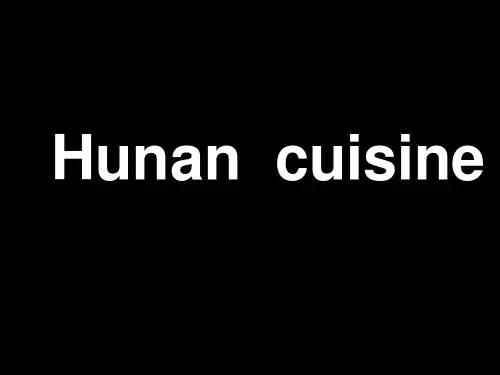


Cultural BackgroundHunan cuisine, sometimes called Xiang cuisine (Chinese: 湖南菜or 湘菜), consists of the cuisines of the Xiang River region, Dong ting Lake and western Hunan Province, in China. Hunan cuisine consists of three styles.Hunan cuisine is one of the eight regional cuisines of China and is well known for its hot spicy(热辣,干辣) flavor(味道), fresh aroma(香味)and deep color. Common cooking techniques include stewing(炖), frying(煎), pot-roasting(烤), braising (焖), and smoking(熏). Due to the high agricultural output of the region, ingredients for Hunan dishes are many and varied.The North and South Dietary differenceReferred to the differences of the North and South, we will first think of the Southern staple food is rice, Northern is flour. The staple food’s differents, causing the entire diet and eat huge’s differences.Small fine and large rough (精细与粗犷)From the amount of food, Southern majority is small but excellent, The north is multi but thick. It rains allthought the year in the south and a variety of vegetables are available.On the contrary we got only several vegetables when the winter comes.History of Hunan cuisineWhen it comes to the Hunan cuisine. What we all have in mind must be one adjective word -pungent. As one of China's most famous eight cuisines. Hunan cuisine has a long history of more than 2000 years. Hunan cuisine has assimilated a variety of local forms, eventually evolving into its own style. It contains 4,000 dishes now, among which over 300 dishes are very notable, such as Dong’an chicken (东安子鸡) and smoked pork with dried long green beans(干豆角蒸腊肉).Why pungent1.Geographic and weather factorsAs Hunan is located in the south-west of China. There have many rivers and lakes such as Dongting-lake. People here must suffer the wet environment. Pepper yield and quality are very impressive and very suitable for consumption in Hunan.2.the economic and circulation causesIn ancient times, Hunan is an economically and traffic underdeveloped regions. Some areas were especially poverty. Salt has always been expensive here. Pepper stimulate taste and with disinfection function, just as a substitute for salt.Hunan cuisine is known for its liberal use of chilly peppers, shallots(青葱)and garlic(大蒜). Its dishes tend to be dry hot (干辣) or purely hot which distinguish from (hot and numbing 失去感觉的;麻辣的)in Sichuan cuisineCharacteroutput of the region, ingredients for Hunan dishes are many and varied. Hunan Cuisine isoften spicier by pure chili content, contains a larger variety of fresh ingredients, tends to be oilier, and is said to be purer and simpler in taste An obvious characteristic of Hunan cuisine, in general, Hunan cuisine uses smoked and cured goods in its dishes much more frequently.And the menu changes with the seasons is another feature of Hunan cuisine.Famous Food of Hunan cuisine1Steamed fish head with chopped pepper(剁椒鱼头)The dish is bright red in color and tastes delicious. It is prepared with the head of a bighead carp and spicy thick sauce is made according to a secret recipe.2 Mao’s b raised pork with soy sauce (毛氏红烧肉)Red-braised pork is a dish that in Hunan is inseparably bound up with the memory of Chairman Mao: many restaurants cal it “The Mao family’s red-braised pork.”Mao Zedong loved it, ate it frequently, and is said to have insisted his Huananese chefs cook it for him in Beijing. It’s a robust concoction, best eaten with a plain steamed rice and simple stir-fried vegetables, but the sweet, aromatic chunks of meat are irresistible and it’s always a favorite at my London dinner parties. In keeping with traditional Chinese gastronomy, which seeks to make a medical virtue out of every dietary predilection, the people of Mao’s home village, Shaoshan, recommend a red-braised pork as a health food: “Men eat it to build their brains,”Chairman Mao’s nephew Mao Anping assured me when I met him there a few years ago, “and ladies to make themselves more beautiful”. His friend and neighbor, the Shaoshan communist party secretary, told me he ate two bowlfuls a day to keep his intellect in shape.3 Dong’an Chicken(东安子鸡)Named by its material—the pullet (young hen)Was handed down more than 1000 years from Tang DynastyIs one of the most famous Hunan dishes.4 Spicy Salted Duck(酱板鸭)“Jiangbanya duck”(Changde Spicy and Salted Duck), a local delicacy with a special flavor, is famous all over the country. This delicacy is eye-catching in color, crisp in flesh, fragrant in sauce and savory in taste. It is highly nutritious, and it is also a good choice as dish that goes with wine. It is not only a common local snack but also a speciality in a banquet.5 Changsha Preserved Smelly Tofu(长沙臭豆腐)Changsha stinky tofu features: crisp but not paste, delicate but not greasy, tangy smell bad smell early, fine smell inviting aroma, with white bean curd and fresh, crisp Fried tofu fragrance and crunchy.6 Smoky flavours steamed together(腊味合蒸)Is made by smoked and cured pork(腊肉)、chicken(腊鸡)and fish(腊鱼).Is one of the traditional style dishes of hunan cuisine.Hunan CuisineHunan cuisine, sometimes called Xiang cuisine (湖南菜or 湘菜;), is generally considered in China as one of the eight main cooking styles. Hunan dishes consist of local dishes from the Xiangjiang River area, Dongting Lake area and Western Hunan mountain area.What is Hunan cuisine famous for?The cuisine gives priority to abundance, fatness, smoothness and moistness, mostly take chili as the main course. It not only has the saltiness of the North and the sweetness of the South, but also the hotness and sourness of local characteristics.It is characterized by fragrance, tenderness, clearness and crispness. Its selected materials are based on the principle of being fresh and cheap but good. The cuisine is especially particular about the tastiness of raw materials.Hunan cuisine has varied cooking techniques such as sautéing, stir-frying, steaming and smoking. It is especially good at "stewing" dishes. However, it is most skillful in braising and baking, by which dishes of original flavor can be cooked.Hunan cuisine is also famous for its excellence in cutting techniques, appearance and flavor. The dishes are changeable with all shapes. The special seasonings of the cuisine include soy sauce, tea seed oil, spicy oil, Chinese red pepper, fennel and cassia bark, which add color to the cuisine, which is noted for pungency. The Hunan chili is especially spicy, and local people have a preference for chili which they put in almost everything they eat.How do the geographical factors affect Hunan cuisine?Hunan is known as "the land of fish and rice". Like the west in latitude, it has the added bonus of lowlands for rice cultivation and a rich ocean's edge for fish. So rice and seafood is common in Hunan cuisine.Hunan food is hot because the climate is very humid, which makes it difficult for human body to eliminate moisture. Local people eat hot peppers to help remove excess dampness and cold in the body.What are the features of Hunan cuisine?Chili, pepper and shallot are usually necessaries in Hunan cuisine. The characteristic of Hunan cooking is the liberal use of chillis, which gives it thick and pungent flavor. Hunan cuisine is known for being dry hot or purely hot. Hunan cuisine is often spicier and contains a larger variety of ingredients. Chili, peppers, garlic and an unusual sauce, called "strange-flavor" sauce on somemenus, enliven many dishes, with a somewhat drier intensity than thatof their Sichuan counterparts.Sweetness, too, is a Hunan culinary passion, and honey sauces are favored in desserts such as water chestnut or cassia flower cakes.Another feature of Hunan cuisine is that the menu will change following the season's alternation. In a hot and humid summer, a meal will usually start with cold dishes or a platter holding a selection of cold meats with chilies for opening the pores and keeping cool in the summer. In winter, a popular choice is the hot pot, for heating the blood in the cold months. A special hot pot called "lover's hot pot" is famous for splitting the pot into a spicy and a lighter side.What are the famous courses of Hunan cuisine?Representative dishes:Beer duck (啤酒鸭)Changsha-style rice vermicelli (长沙米粉)Changsha-style stinky tofu (长沙臭豆腐)Dong'an chicken (东安子鸡)"Dry-wok" chicken (干锅鸡)Home-style bean curd (家常豆腐)Lotus seeds in rock sugar syrup (冰糖湘莲)Mao's braised pork (毛氏红烧肉)Numbing-and-hot chicken (麻辣子鸡)Smoky flavours steamed together (腊味合蒸)Steamed fish heads in chili sauce (剁椒蒸鱼头)Stir-fried duck blood (炒血鸭)Stir-fried meat with douchi and chilli peppers (豆豉辣椒炒肉)Pearly meatballs (珍珠肉丸)Well-known Snacks:Pumpkin cakeFermented Bean CurdSisters‘Glutinous Rice BallsXiangtan RollHengyang Pailou Tangyuan (stuffed balls made of glutinous rice flour served in soup)Shrimp CakeRice TeaWhat is the established history of Hunan cuisine?The history of the cooking skills employed in the Hunan cuisine date back many centuries. As early as the Western Han Dynasty, 2,100 years ago, the cooking skills of Hunan cuisine reached a high standard. During the course of its history, Hunan cuisine assimilated a variety of cuisine styles, and then developed its own style. Now it contains more than 4,000 dishes, amongwhich over 300 dishes are very famous, such as fried chicken with Sichuan spicy sauce and smoked pork with dried long green beans.。
英语作文介绍湘西美食Hunan cuisine, also known as Xiang cuisine, is one of the eight famous regional cuisines in China, known for its spicy and aromatic flavors. 湖南菜,又称湘菜,是中国八大菜系之一,以其辛辣和香气四溢而闻名。
First and foremost, the most famous dish in Hunan cuisine is probably "mao xue wang", a hot pot dish made with the most tender parts of the cow or pig, and cooked with blood tofu and various vegetables. 首先,湖南菜中最著名的菜肴可能是“毛血旺”,这是一道火锅菜,用牛或猪最嫩的部位、血豆腐和各种蔬菜烹饪而成。
Furthermore, another iconic dish in Hunan cuisine is "duojiao yutou", which consists of fish head cooked in a spicy and sour sauce made from pickled chilies and fermented soybeans. 此外,湖南菜的另一道标志性菜肴是“剁椒鱼头”,由鱼头烹制而成,搭配上用泡制的辣椒和发酵豆豉制成的酸辣酱。
Additionally, "la zi ji", or spicy chicken, is another well-loved dish in Hunan cuisine. It is made by deep-frying chicken pieces and thenstir-frying them with red chili peppers and Sichuan peppercorns for a numbing and spicy flavor. 此外,“辣子鸡”是湖南菜中另一道备受喜爱的菜肴。
湘菜系介绍英文作文英文:As a native of Hunan province, I am proud to introduce the Hunan cuisine, also known as Xiang cuisine. Hunancuisine is one of the eight major regional cuisines in China, and it is known for its bold and spicy flavors.One of the most famous dishes in Hunan cuisine is the spicy stir-fry, which is made with a variety of ingredients such as pork, chicken, beef, or vegetables, and is seasoned with spicy chili peppers, garlic, ginger, and otherflavorful spices. Another popular dish is the "Dong'an chicken," which is a crispy fried chicken dish that is coated in a spicy sauce made with chili peppers, soy sauce, and other ingredients.Hunan cuisine also has a wide variety of soups, stews, and hotpots, such as the "Mao's braised pork," which is a slow-cooked pork belly dish that is flavored with soy sauce,ginger, garlic, and other spices. Another famous hotpot dish is the "Changsha-style spicy frog," which is a spicy and flavorful frog dish that is cooked in a hotpot with a variety of vegetables and spices.In addition to its spicy and bold flavors, Hunan cuisine also emphasizes the use of fresh and seasonal ingredients, as well as the balance of flavors and textures in each dish. Hunan cuisine is a perfect representation of the rich and diverse culinary traditions of China.中文:作为湖南人,我很自豪能够介绍湘菜,也叫湖南菜。
湘菜英文介绍作文Shanxi cuisine, also known as Xiang cuisine, is a style of Chinese cuisine that comes from the Shanxi province in northern China. It is known for its bold flavors, generous use of spices, and hearty, filling dishes.The most famous dish in Shanxi cuisine is probably the sliced noodles, which are handmade and served in a rich, flavorful broth. The noodles are chewy and satisfying, and the broth is often infused with the flavors of pork, beef, or lamb.Another popular dish is the Shanxi-style braised pork, which is cooked in a savory, sweet sauce that is rich with the flavors of soy sauce, ginger, and star anise. The pork is tender and succulent, and the sauce is the perfect accompaniment to a bowl of steamed rice.Shanxi cuisine also features a wide variety of dumplings, which are often filled with a mixture of meatand vegetables. These dumplings are typically served with a dipping sauce that is tangy and spicy, adding a burst of flavor to each bite.In addition to these main dishes, Shanxi cuisine also includes a variety of cold appetizers, soups, and stir-fried dishes. These dishes often feature a mix of textures and flavors, from crunchy vegetables to tender meats, and from spicy to savory.Overall, Shanxi cuisine is a celebration of bold flavors, hearty dishes, and a love of good food. It is a cuisine that is meant to be shared with friends and family, and enjoyed in a warm, welcoming atmosphere. If you ever have the chance to try Shanxi cuisine, don't hesitate you won't be disappointed!。
湘菜作文介绍英语Xiang cuisine, also known as Hunan cuisine, is one of theeight great culinary traditions of Chinese cuisine. It is famous for its hot and spicy flavors, which are a result ofthe extensive use of chili peppers and garlic. Here is an introduction to Xiang cuisine in English:The Bold Tastes of Xiang CuisineXiang cuisine is a culinary adventure that takes your taste buds on a fiery journey. Originating from the Hunan provincein China, this style of cooking is characterized by its bold flavors, with a strong emphasis on spiciness and sourness.IngredientsThe heart of Xiang cuisine lies in its ingredients. Chili peppers, both fresh and dried, are a staple, used to add heat to a variety of dishes. Garlic is another key ingredient, adding a pungent aroma and flavor. Other common ingredients include shallots, ginger, and a variety of spices that create a complex flavor profile.Cooking TechniquesCooking techniques in Xiang cuisine often involve stir-frying,which helps to preserve the freshness of the ingredients andto infuse them with intense flavors. The quick cookingprocess also helps to maintain the texture of the ingredients, resulting in dishes that are both tender and crisp.Signature DishesSome of the most iconic dishes in Xiang cuisine include:1. Stir-Fried Spicy Chicken (Gan Bian Ji): A dish that combines the heat of chili peppers with the tenderness of marinated chicken, creating a dish that is both spicy and flavorful.2. Steamed Fish Head with Diced Hot Red Peppers (Duo Jiao Yu Tou): This dish showcases the use of fresh red peppers, which are diced and steamed with a fish head, resulting in a dish that is both visually striking and full of flavor.3. Hunan Braised Pork (Hu Nan Hong Shao Rou): A slow-cooked pork dish that is tender and flavorful, with a sweet andspicy sauce that is a hallmark of Xiang cuisine.4. Smoked Tofu (Yan Dou Fu): A unique dish where tofu is smoked to give it a distinct flavor, often served with aspicy sauce.Cultural SignificanceXiang cuisine is not just about the food; it's also deeply rooted in the culture of Hunan. The province's humid climateand history of rice cultivation have influenced the cuisine, with rice being a staple in many dishes. The use of chili peppers is believed to help dispel dampness and cold, which is common in the region's climate.ConclusionExploring Xiang cuisine is an experience that will challenge and delight your palate. Each dish is a testament to theskill of the chefs and the rich culinary heritage of Hunan. Whether you're a fan of spicy food or simply looking to expand your culinary horizons, Xiang cuisine offers a world of flavors waiting to be discovered.This introduction to Xiang cuisine provides a brief overview of its key characteristics, cooking techniques, and some of the most famous dishes. It also touches on the cultural significance of the cuisine and its importance in the Hunan province.。
介绍湖南湘菜的作文English Answer:Introduction to Hunan CuisineHunan cuisine, also known as Xiang cuisine, is one of the eight major culinary traditions in China. It originates from the Hunan province in central China and is famous for its spicy and flavorful dishes.Hunan cuisine is characterized by its bold and pungent flavors. It heavily relies on the use of chili peppers, garlic, and shallots, which give the dishes a fiery and aromatic taste. The cuisine also emphasizes the freshness and natural flavors of ingredients, with an emphasis on stir-frying, deep-frying, and braising techniques.Some popular dishes in Hunan cuisine include the famous "Chairman Mao's favorite red-braised pork," which is a succulent and tender pork dish cooked in a rich and savory sauce. Another popular dish is "spicy diced chicken," which is a stir-fried chicken dish seasoned with a variety of spices and chili peppers.Hunan cuisine is not only known for its spiciness but also for its diverse range of flavors. It incorporates a balance of hot, sour, sweet, and salty tastes, creating a harmonious blend of flavors in each dish. The cuisine also makes use of a wide variety of ingredients, including meats, vegetables, and tofu, ensuring a wide range of options for both meat lovers and vegetarians.In conclusion, Hunan cuisine is a vibrant and flavorful culinary tradition that showcases the bold and spicy flavors of the Hunan province. Whether you are a fan of spicy food or simply enjoy exploring new tastes, Hunan cuisine is definitely worth trying.中文回答:湖南湘菜介绍湘菜,也被称为湖南菜,是中国八大菜系之一。